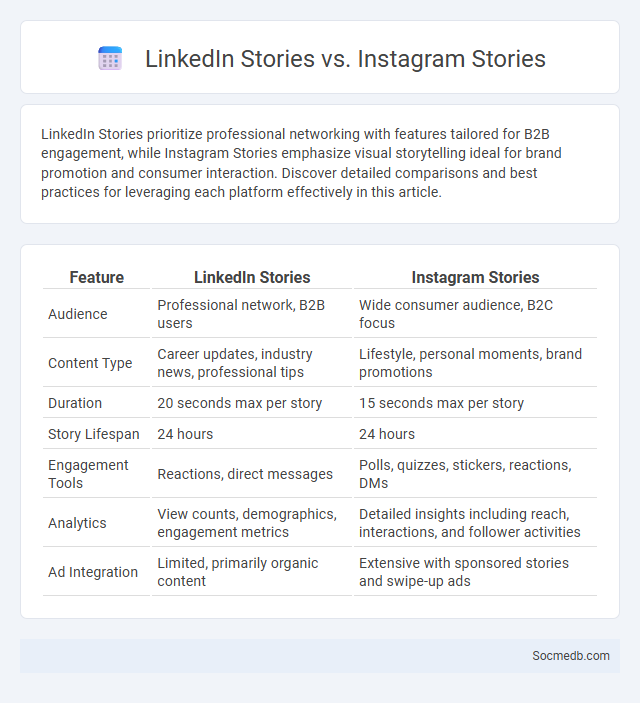
Photo illustration: LinkedIn Stories vs Instagram Stories
LinkedIn Stories prioritize professional networking with features tailored for B2B engagement, while Instagram Stories emphasize visual storytelling ideal for brand promotion and consumer interaction. Discover detailed comparisons and best practices for leveraging each platform effectively in this article.
Table of Comparison
| Feature | LinkedIn Stories | Instagram Stories |
|---|---|---|
| Audience | Professional network, B2B users | Wide consumer audience, B2C focus |
| Content Type | Career updates, industry news, professional tips | Lifestyle, personal moments, brand promotions |
| Duration | 20 seconds max per story | 15 seconds max per story |
| Story Lifespan | 24 hours | 24 hours |
| Engagement Tools | Reactions, direct messages | Polls, quizzes, stickers, reactions, DMs |
| Analytics | View counts, demographics, engagement metrics | Detailed insights including reach, interactions, and follower activities |
| Ad Integration | Limited, primarily organic content | Extensive with sponsored stories and swipe-up ads |
LinkedIn Stories vs Instagram Stories: Key Differences
LinkedIn Stories prioritize professional content tailored for networking, featuring industry updates, job-related insights, and career milestones, while Instagram Stories emphasize visually engaging, lifestyle-oriented posts like personal moments, brand promotions, and entertainment. Your choice between LinkedIn Stories and Instagram Stories should align with whether your goal is to build a professional brand or to engage with a broader, more casual audience. Engagement metrics like LinkedIn's emphasis on business connections contrast with Instagram's focus on creative interactions and influencer reach.
Understanding Feed Ranking Algorithms
Feed ranking algorithms analyze user interactions, content relevance, and trending topics to prioritize posts in social media feeds. Machine learning models evaluate factors such as engagement rates, recency, and personalized preferences to deliver tailored content. Optimizing content for these algorithms increases visibility and drives higher user engagement.
Audience Engagement: Stories vs Feed
Social media audience engagement varies significantly between Stories and Feed content, with Stories offering ephemeral, interactive elements like polls and quizzes that boost real-time participation. Feed posts provide lasting visibility and allow deeper storytelling through captions and curated visuals, fostering sustained user interaction over time. Brands leveraging Stories alongside Feed content benefit from both immediate engagement and consistent audience presence, maximizing overall reach and connection.
Content Types That Perform Best on Each Platform
Instagram excels with visually striking images and short-form videos, especially Reels that boost engagement through dynamic storytelling. TikTok's algorithm favors creative, trend-driven short videos often under 60 seconds, making authenticity and viral challenges key to success. On LinkedIn, professional articles, industry insights, and concise video content perform best, fostering networking and thought leadership within targeted business communities.
Algorithmic Impact on Story Visibility
Social media platforms use complex algorithms to determine story visibility, prioritizing content based on user engagement, relevance, and recency. These algorithms analyze factors such as likes, shares, comments, and viewing time to rank content in users' feeds, influencing which stories gain more exposure. The algorithmic impact often leads to echo chambers by promoting content aligned with users' previous interactions, affecting the diversity of visible information.
Strategies for Maximizing Reach on LinkedIn and Instagram
Maximizing reach on LinkedIn and Instagram requires leveraging platform-specific strategies such as consistent posting schedules, utilizing relevant hashtags, and engaging with targeted communities to increase visibility. Tailoring content to professional audiences on LinkedIn while using visually compelling posts and Stories on Instagram enhances audience interaction and shareability. Your ability to analyze platform analytics and adapt content accordingly ensures sustained growth and broader reach across both networks.
Measuring Success: Analytics and Metrics
Social media success hinges on analyzing key metrics such as engagement rates, reach, and conversion rates to quantify audience interaction and business impact. Platforms like Facebook Insights, Instagram Analytics, and Twitter Analytics provide detailed data on user demographics, post performance, and click-through rates essential for refining content strategies. Tracking return on investment (ROI) through these analytics enables brands to optimize campaigns, target audiences more effectively, and drive measurable growth.
Adapting Your Content for Platforms’ Ranking Systems
Adapting your content for platforms' ranking systems requires understanding each algorithm's unique criteria such as engagement rate, watch time, and relevance. Tailor your posts by incorporating trending keywords, optimal posting times, and interactive elements like polls or comments to boost visibility. Your strategic content adjustments increase organic reach and help maintain consistent audience growth across social media channels.
Cross-Promotion: Leveraging Both Stories and Feed
Cross-promotion on social media effectively amplifies your brand reach by utilizing both Stories and Feed posts to engage diverse audience segments. Stories capture real-time interactions with ephemeral content, while Feed posts provide lasting visibility and detailed messaging. Combining these formats maximizes exposure and drives consistent engagement across platforms.
Future Trends in Social Media Content Ranking
Future trends in social media content ranking will increasingly rely on advanced AI algorithms that prioritize personalized user experiences through real-time behavior analysis and predictive engagement metrics. Platforms will integrate multimodal data, including text, images, and video, to enhance content relevance and improve ranking accuracy. Enhanced transparency and user control over algorithmic filters will become critical as privacy concerns and content authenticity demand higher standards.
 socmedb.com
socmedb.com